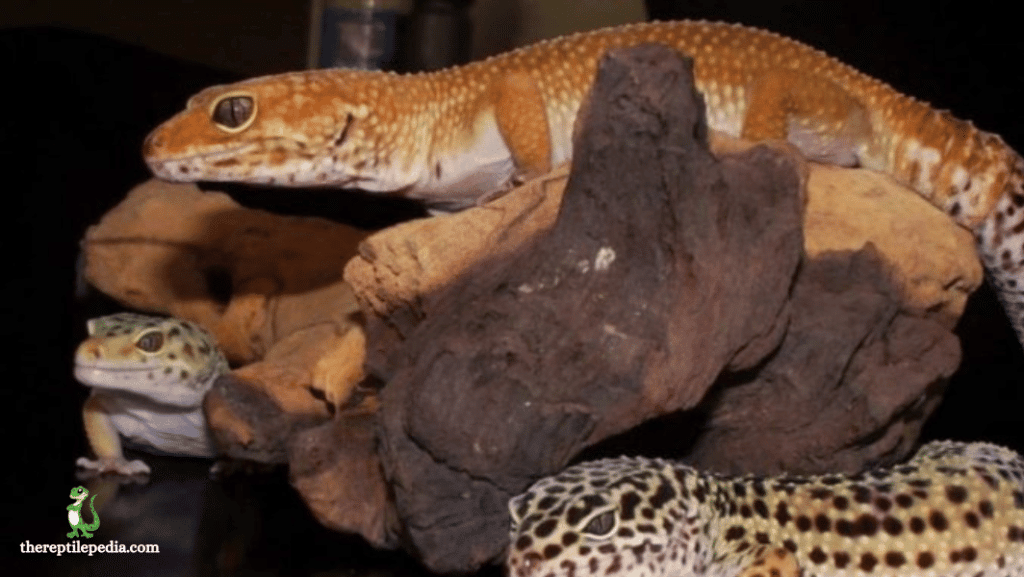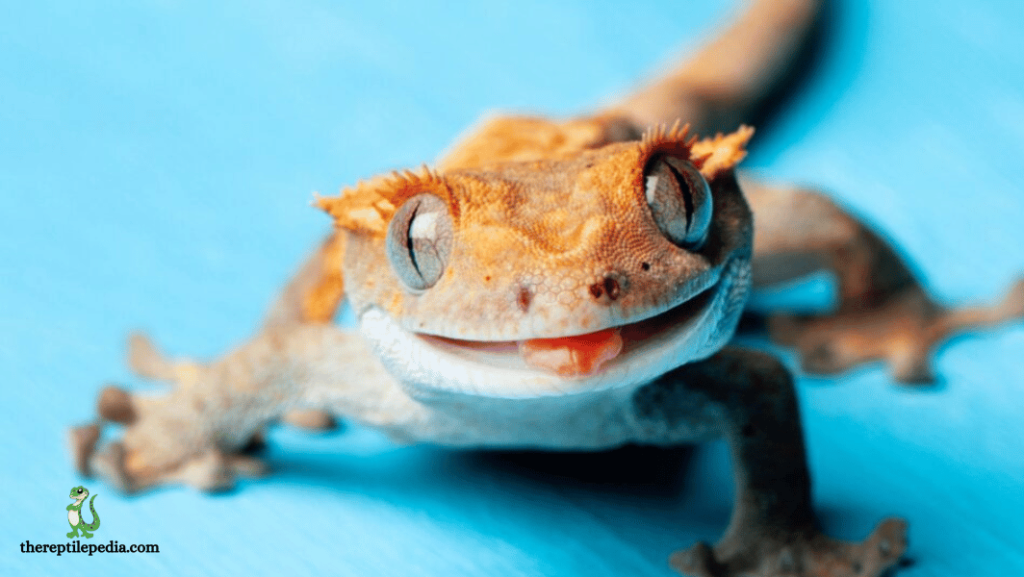In an exciting world where we often wondered what goes on in our pets’ heads, the Leopard geckos stand out as animals that communicate their emotions not with language we can easily understand, but through vocal and posture cues. Unlike the loud expressions of some pets, these geckos prefer a subtler approach, using sounds like Leopard Geckos Chirp, clicking, and even the occasional barking or screaming to speak volumes. This display of emotions, from contentment to distress, showcases their unique way of interacting with the world around them, offering us a glimpse into their thoughts without a single word.
If you’ve arrived at this article because you’ve experienced a strange noise from your leo, you’re not alone. Many owners, after surfing the web and learning about these unique noises, find themselves asking why leopard geckos chirp. These noises, ranging from chirps to clicks, are part of their vocal behavior.
Research suggests that chirping could signal various states—whether your gecko is feeling threatened, stressed, hungry, or it might just be their way of mating display.
In some cases, it could even mean they’re happy! It’s fascinating to look at the handful of sounds they produce and understand the difference between each. By comparing these noises to what chirping means, we can better examine the scenarios that bring about this behavior and watch for other signs to ensure our leo’s are content and healthy.
Table of Contents
Chirping: What’s Behind the Sound?
If you’ve had your fair share of time keeping a leopard gecko, you’ve probably heard the various sounds these little critters make. Despite not being the most vocal of lizards, they’re far from mute. Amidst the different noises that leos can produce, deciphering what each sound means can be quite intriguing, specifically when it comes to the chirp. This particular noise is more than just a sound; it’s a way for these geckos to tell us something, whether they’re feeling happy, stressed, or seeking attention. Understanding the nuances behind each chirp helps us better connect with and care for our scaled friends.
Understanding the subtle noises your leo makes can be difficult, especially when trying to discern a chirp from other sounds. When you’re around, take a moment to listen closely to the vocal patterns your reptile friend produces. Each noise, from the squeaking often referred to as chirping, to the more obvious shrill of screaming, the clicking, and even barking, holds a different meaning.
Screaming, for instance, is a loud, unique sound, primarily released by juveniles not yet used to humans, serving as an ultimate defensive mechanism to scare away any potential predator.
Why Do Leopard Geckos Chirp?
Leopard geckos communicate through various sounds, including chirping and clicking, which can be attributed to different situations and emotions. Below is a table summarizing the common scenarios in which these vocalizations occur:
| Situation | Description |
| Feeling Threatened | Leopard geckos may chirp when they feel threatened or scared, as a way to express discomfort or warn off potential threats. |
| Mating Calls | During mating season, males may produce chirping or clicking sounds to attract females or communicate with potential mates. |
| Territorial Disputes | Chirping can also occur during territorial disputes between geckos, serving as a form of aggressive communication to assert dominance. |
| Hunger or Excitement | Sometimes, leopard geckos chirp when they are hungry or excited, especially if they associate their owner’s presence with feeding time. |
| Social Interaction | Chirping and clicking might be used as a form of social interaction between geckos, indicating a desire for attention or interaction. |
Reasons Your Leopard Gecko is Chirping
we’ll explore the various factors that might cause your leopard gecko to vocalize in this unique way.
Reason 1: Feeling Scared or Threatened
When leopard geckos emit random noises, it’s often a sign of fear or feeling threatened, despite being in the safe place of their enclosure. These petite lizards are always on constant watch for predators, a survival instinct from the wild. Chirps are heard as an instinctual response to situations they perceive as dangerous, even if they don’t know the hazard isn’t real. Unable to speak in a language humans can comprehend, leos utilize their body posture and vocal adaptations to protect themselves and ward off potential threats. This complex behavior highlights the depth of their instinctual world, reminding us of the care needed to make them feel secure.
When your leopard gecko feels threatened, it might display a series of behaviors including chirping noises. This display often consists of flicking or wiggling its tail back and forth, tense limbs, and might culminate in the gecko either biting or scurrying swiftly away from the perceived danger. This is essentially your leo’s last chance to startle predators and retreat to safety. While witnessing this might seem amusing to some, it’s important to respect that your pet is fearful of a stimulus in its environment.
By working towards resolving these stressors, you not only eliminate potential threats but also help your gecko feel more comfortable. A calm and quiet gecko is often a sign they feel safe and thank you in the only way they know best.
Reason 2: Handling Mistakes
When juvenile leopard geckos chirp, it’s often a reaction to being handled, a stark contrast to adult geckos who are more familiar with their owners and the sensation of being held. For juveniles, everything is new; they find themselves insecure in an unfamiliar environment, especially if they’ve just been adopted and brought into a new home. The sight of a giant hand might be perceived as a larger predator, sparking fear for their lives since, at their core, they are still reptiles. The act of trying to scoop them up can trigger chirps, leaving many owners taken aback by this instinctual response.
When a baby leopard gecko is first brought into a new home, it’s crucial to let them settle for a few weeks before starting the bonding process. Interactions should be slowly increased in short intervals each day to limit stress and maintain a gentle approach with your new buddy. It’s normal for your gecko to send chirps towards your hand until they become comfortable with the interaction.
Similarly, don’t worry if an adult leo chirps when you pick them up; each individual is different. Whether you’ve rescued your reptile as an adult, they’ve just ate, are about to shed, or are naturally a skittish fellow, understanding that not all geckos will immediately accept friendship with their human is key to a harmonious relationship.
Sometimes, if you find your gecko chirping, it might be a possibility that you’re holding them too tightly or squeezing, which creates discomfort. These chirps aren’t sounds of enjoyment; rather, they’re a signal that your pet might not be in the mood to be social, especially if they’re young and afraid, or naturally an introvert.
If your handling feels rough to them, the best response is to leave them alone, giving them some alone time and deciding to try again a little bit later. Remember, patience will be your greatest reward in handling a leopard gecko. Use these noises as a reminder to step back and approach them more gently next time.
Reason 3: When They Feel stress or discomfort

When leopard geckos make a noise, it’s not always a sign they’re happy; often, it’s quite the opposite. If your leo starts to communicate through sounds, it could indicate they’re unhappy or stressed. To address this, examine your gecko’s enclosure and setup. Incorrect housing or layout, improper temperature gradient, humidity fluctuations, or even insecurity and boredom can be the culprits. Ensure there are at least two hides, one humid for shedding, and provide ample decor for enrichment. Use a thermometer and hydrometer to keep a watch on the heat and humidity levels, adjusting as necessary to keep your gecko entertained and comfortable.
Maybe your leopard gecko goes from being quiet in its enclosure to a frantic mess the second you bring it elsewhere, driven by fear of unfamiliar surroundings. This vocal response, often in tandem with changes in body posture and tail flicking, signals discomfort. Chirps might believe to be a case of your gecko not feeling safe. To help, gently grab your leo and put it back in its home to build its confidence over time through shorter interactions, ensuring you’re not forcefully keeping it out when it isn’t having it.
Anxiety in leopard geckos can stem from their instinctual role as prey in the wild, making it simple to determine when they’re stressed but harder to find the root of the tension. Note that their chirps and body posture can offer clues, as these often resemble reactions to stimuli in their surrounding environment that cause discontentment. The key is to work on finding a solution to alleviate their stress and create a more comfortable habitat for them.
Also Read: Leopard Gecko Pale And White
Reason 4: Indicating Appetite or Hunger
Have you ever noticed your usually quiet leopard gecko becoming noisy around dinner time, especially if you’re a few hours behind schedule? This is your leo’s way of communicating. Perhaps it just finished shedding and its belly is empty, so the chirping is to let you know it wants those insects. Hunger pangs are a common reason for such vocalizations, with the chirping increasing around mealtime. This sound can also express excitement about eating the delicious prey you’re about to provide, stirring in their tank in anticipation.
When you hear your leo chirps, take notes of what’s happening around them; they’re trying to speak to you in their own way. Realizing that a gecko’s chirp can be a sight of understanding their needs, whether it’s food to relieve stress or just showing they’re content. Knowing your gecko isn’t upset or unhealthy, but rather eager to eat or sung in delight, brings a sense of connection. You might arrive home plenty of times to get an audibly display of gratitude, a small yet profound way your gecko communicates.
Reason 5: Breeding Communication Signals
When a male leopard gecko becomes sexually mature, typically between 18 to 24 months of age or when reaching a weight range of 35-40g, their behavior takes an interesting turn, especially if you have one at home. It’s crucial to pay extra attention during this period, as mating calls become a prominent reason for their chirping. In a somewhat humorous way, a male will attempt to entice a female by making chirping noises and frantically shaking his tail, mimicking a rattlesnake. This is their unique effort to court and impress the female, who typically prefers to lay low and stay quiet during this display.
When a male leopard gecko reaches maturity, often marked by reaching a proper size, its behavior can include territorial displays. This might involve fights with other males over territory, accompanied by distinctive chirps. To avoid such conflicts, it’s wise to house a male leopard gecko alone, ensuring he is cared for independently from other geckos. While you might not witness this so-called love dance in a baby gecko, these chirps serve as a reason to keep looking into the fascinating behaviors and communication methods of these creatures.
Reason 6: Signs of Joy and Satisfaction
Ever noticed your leopard gecko making those adorable chirping noises while you’re sprawled on the couch or bed, finding your moment of comfort? It’s not without a rhyme or reason. These random chirps are their way of expressing happiness. When your leo spots you, the joy is evident. After all, to them, you’re not just the sole provider of food but also a beloved buddy.
The bond is strong; they recognize their owners and get visibly excited upon seeing or hearing you. It’s a unique aspect of their behavior, especially if you often let them out of their tank to hang out. This interaction, this shared space on your relaxing comfortable furnishings, is when they’re most likely to vocalize their contentment. It’s their way of saying, “All is well in my world.”
When your leopard gecko begins chirping, it’s often a sign they’re feeling quite at ease in their enclosure. Far from the stress and fear that can lead to radio silence in the reptile world, these sounds can indicate a level of contentment that comes from exploring a well-remodeled or updated home.
As owners, observing our geckos roaming about and interacting with their surroundings in such a way brings a sense of bonding, knowing that minimal changes on our part can greatly influence their emotions. It’s a subtle reminder that in the world of minimal science, understanding these creatures requires tuning into their unique ways of communication.
Also Read: Can Leopard Geckos Eat Slugs?
Figuring Out Why Geckos Chirp

To really get why your leopard gecko is chirping, it’s all about paying close attention. In my own experience with my gecko, Leo, I’ve noticed that his chirps vary with what’s going on around him. When I walk into the room during his feeding time, his chirps are more excited, almost as if he’s saying, “Finally, food time!” But there was this one time I rearranged his tank, adding some new hides and plants, and his chirps seemed more curious and exploratory, like he was saying, “Wow, what’s all this new stuff?”
And then, there were softer chirps when he was just settling down, content after a good meal or a warm bask. It’s fascinating how these little sounds can give such insight into his mood and needs. Watching and listening to Leo’s chirps has really helped me understand him better and bond with him on a deeper level.
Understanding Their Vocal Expressions
leopard gecko as your new pet opens up a world of different noises, each with its own meaning. Screams, barks, chirps, and clicks form the unique soundscape of these charming reptiles. For many owners, screaming is the most common sound, particularly from baby and juvenile leopard geckos who are still getting used to interacting with human companions. This sound is often a defensive action or a plea for space, especially when they feel threatened or unhappy. Clicking, on the other hand, can be an indicator of discomfort, while chirps might be mating calls.
Proper handling and training can help your gecko become more accustomed to your presence, reducing screams and clicks of fear or stress. It’s important for new owners to realize that these vocalizations are a way for the gecko to interact and report their feelings. Gently setting them back into their habitat allows them a chance to relax and feel safe. For the curious, there are YouTube videos that vividly illustrate these sounds, providing a closer look into the noises you might hear from your pet. Understanding these cues is crucial, as it helps to foster a stronger bond between you and your gecko, ensuring they don’t feel the need to try and attack out of fear.
Also Read: ButterWorms for Leopard Geckos
Conclusion:
Our discussion on leopard gecko vocalizations, particularly chirping and clicking, hopes to have been helpful in shedding light on these behaviors. While mating calls might be an answer for some, it’s important to remember that many owners are housing a single gecko, making stress a more likely culprit. Ensuring Leo’s environment is stress-free is crucial to avoid these sounds. Although they may sound cute, it’s essential to understand they’re not made for entertainment’s sake but are vital communications from your pet. Recognizing and addressing the causes behind these sounds can lead to a happier, healthier gecko.
FAQs:
-
Why do geckos chirp at night?
Geckos chirp at night to communicate, often for mating or establishing territory. Being nocturnal, they’re most active after dark, making nighttime the prime time for these vocal interactions. Recognizing these chirps can provide insights into the fascinating nocturnal behaviors and social dynamics of these intriguing creatures.
-
Why do leopard geckos scream?
Leopard geckos scream as a defense mechanism, usually when they feel threatened or scared. This startling vocalization serves to deter predators or unwanted interactions, signaling discomfort or fear. Understanding this behavior is key to providing a safe, stress-free environment for these sensitive and expressive reptiles.

